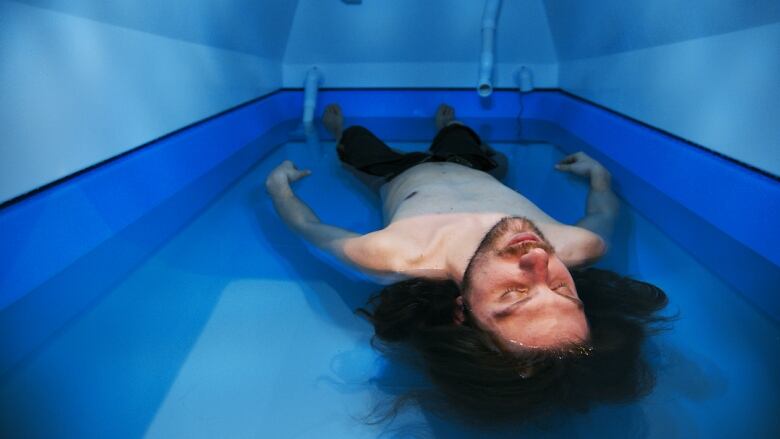'Surrender and relax': Float therapy trend grows, offering watery escape
Nearly 90 float locations across Canada offer warm, salty tanks that block sound, light and the world

Rich Workman didn't know what to expect the first time he tried a sensory deprivation float tank.
He had a gift certificate from a charity auctionand climbed into the warm salty waters of Vancouver's Float House for a break on a Friday afternoon.
"It felt like I was lying in bed at first, and then itjust felt like the bed dropped away."
Before leaving, he bought two more sessions.
Float therapy, once a craze of the 80s, is again growing rapidly in Canada, fuelled in part by celebrity endorsements and a desire to unwind.
For the industry to last this time, a key will be attracting floaters back after their first 'whoa' moment.

'I was a little anxious'
Float House co-owner Mike Zaremba remembers his first float, in a massage therapist's basement in Coquitlam, B.C.
"At first I was a little anxious," Zaremba said. "It's a very strange thing to go into a dark space with water ... that environment does not exist anywhere else on Earth where we have maximal sensory reduction."
Float tanks are usually white, made of fibreglass, and designed to block out the world.
At Float House, each tank sits in a private room, where the user strips and showers alone, before climbing in. Closing the hatch for total darkness is optional.
Inside, the water is about ankle-deep, heated to skin temperature, and loaded with about a tonne of Epson salt making it so dense a person is buoyant without effort.
"It felt like I was in my mom's womb," said first-time floater Nayling Materan.

The idea is, without outside stimuli, the body's natural relaxation response is invited to take over provided thoughts and worries don't rule instead.
Zaremba said he couldn't relax until about minute 50 of his first 60-minute float, but then was hooked.
"At the end of my session I was able to kind of ... surrender and relax to the experience," he said.
"When you can trust it, that's where it begins."
With his brother, he bought a float tank for their apartment then launched Vancouver's first float centre in 2013, offering 90-minute sessions.
Now, at least five companies are operating in the city, and 87 float locations are open across Canada, with 30 of those springing up since January 2016, according to the industry Floatation Locations.

80s craze
Float therapy has risen to prominence before, having seen a heyday in the 80s where professional athletes and tranquility-seekers gave it a go.
In 1982, the Washington Post called it a "new concept for reducing stress," dubbing the tank a "coffin-like bathtub."
My subjective experience is that I am floating in outer space- Peter Suedfeld, UBC emeritus professor of psychology
At that time, Peter Suedfeld, a now-emeritus professor of psychology at the University of B.C., was studying sensory-restricted environments, including floating.
He said large controlled clinical trials weren't done, but some studies have pointed to benefits for conditions like high blood pressure and stress-related pain.
"And it's pleasant," he said. "Usually when I float, my subjective experience is that I am floating in outer space."
He thinks the earlier fad died for a few reasons: it was the early days of the AIDS crisis, and people had unfounded fears about climbing in the tanks.
Plus, the novelty wore off.
"Once you've exhausted the group of adventurous curious people, your customer base is ... not totally gone but much reduced," said Suedfeld.

Evolving demand
As the industry has expanded, and Float House has grown from five tanks to six franchise locations, Zaremba says some of that has already happened.
"There's a lot of supply to meet an evolving demand," he said.
"The early adopters have come and gone, and they use it as they do."
Some floaters return regularly for help with aches and pains, or in Jaia Kydd's case, a creative boost.
"I felt a little overdue for a float ... the pace of life was just getting to me."
Suedfeld thinks float therapy is helpful enough for people it won't be a fad this time, though he doesn't float much anymore himself.
"To tell you the honest truth, I enjoy stress."
Listen to the CBC Radio special Keep Calm on the science of business of handling stress, or read more in the series here:












_(720p).jpg)


 OFFICIAL HD MUSIC VIDEO.jpg)
.jpg)



























































































